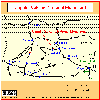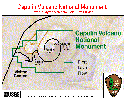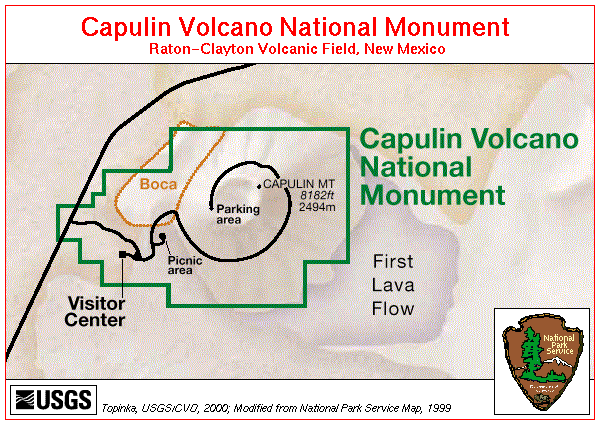|
-
Capulin Cinder Cone
-- Geographic Setting, Geologic and Eruptive History
Capulin Volcano
a nearly perfectly-shaped cinder cone, stands more
than 1,200 feet above the surrounding High Plains of northeastern New
Mexico. The volcano is long extinct, and today the forested slopes
provide habitat for mule deer, wild turkey, black bear and other
wildlife. Abundant displays of wildflowers bloom on the mountain
each summer. A 2-mile paved road spiraling to the volcano rim makes
Capulin Volcano one of the most accessible volcanoes in the world.
Trails leading around the rim and to the bottom of the crater allow a
rare opportunity to easily explore a volcano.
-- Excerpt from:
U. S. National Park Service - Capulin Volcano National Monument Website, 1998
-
"America's Volcanic Past" - Capulin National Monument
-- Volcanic Highlights and Features
Capulin Mountain ... Sierra Grande ... Barella, Raton, and Johnson Mesas ...
|
Capulin Volcano National Monument
|
|
Capulin Volcano,
a nearly perfectly-shaped cinder cone, stands more
than 1,200 feet above the surrounding High Plains of northeastern New
Mexico. The volcano is long extinct, and today the forested slopes
provide habitat for mule deer, wild turkey, black bear and other
wildlife. Abundant displays of wildflowers bloom on the mountain
each summer. A 2-mile paved road spiraling to the volcano rim makes
Capulin Volcano one of the most accessible volcanoes in the world.
Trails leading around the rim and to the bottom of the crater allow a
rare opportunity to easily explore a volcano.
Capulin Volcano erupted approximately 60,000 years ago with
firework-like "rooster tails" of glowing hot cinders that flew through
the air. Lava that flowed from vents located at the volcano's flank
covered almost 16 square miles. Although no longer a volcano in
action, Capulin Volcano remains a dramatic testament to the
volcanic processes that shaped northeastern New
Mexico. Capulin Volcano National Monument was established
in 1916 to preserve this striking example of a
volcanic cinder cone.
The Crater Rim Trail
is one mile and the
Crater Vent Trail is 0.2 miles.
The Lava Flow Trail at the base of the volcano is one mile.
Excerpts courtesy of:
U. S. National Park Service - Capulin Volcano National Monument Website, 1998
|
For More National Monument Information
|

Link to:
Capulin Volcano National Monument Website
Capulin Volcano National Monument,
P.O. Box 40,
Capulin, New Mexico 88414
(505) 278-2201
|
|
If traveling by car, the monument is located 33 miles east of
Raton, New Mexico, via U. S. Highway 64/87 and 58
miles west of Clayton, New Mexico, via the same highway.
The park entrance is off New Mexico Highway 325, 3
miles north of the town of Capulin.
Interstate 25 connects Raton with Denver, Colorado, from the north,
and Albuquerque and Santa Fe, New Mexico, from the south.
The Volcano Road, which leads to the rim, is
approximately two miles long. Trailers, towed vehicles,
bicycles, and pedestrians are prohibited
because the road is narrow and has no shoulders. The road is closed
after park hours. Snow, ice accumulation,
and/or severe thunderstorms can also close the Volcano Road.
Current road conditions are available by
calling monument headquarters.
-- Excerpts courtesy of:
U. S. National Park Service - Capulin Volcano National Monument Website, 1998
|
-

[Map,16K,InlineGIF]
Location of Capulin Volcano National Monument
-- Modified from: U. S. National Park Service, 1999
-

[Map,73K,InlineGIF]
Capulin Cinder Cone
-- Modified from: U. S. National Park Service, 1999

|
Have you ever wanted to walk into a volcano?
Well,
Capulin Volcano is one of the few places in the
world where you can do that. A
3-kilometer (2-mile) road spirals to the summit,
ending at a parking
area, where two self-guiding trails begin.
One trail, 0.3 kilometers (0.2 miles) long, goes down to the
bottom of the crater to the vent and gives
you an unusual opportunity to see the inside of a volcanic
mountain. The second is the Crater Rim Trail,
1.6 kilometers (1 mile) long, a self-guiding path that
follows the rim all the way around. The trail
begins with a moderate climb, but once on the rim you will
find the going fairly easy until you begin the
descent to the parking lot. From the trail, you can also look
out over the land through which the "Cimarron Cut-Off"
of the Santa Fe Trail passed. During the
late-19th century, wagon trains bound for
Fort Union traveled this route. The view westward is
particularly magnificent. The majestic, snowcapped
peaks of the Sangre de Cristo Mountains form a
mighty backdrop to the wide expanse of rangeland,
broken by volcanic hills and mesas. Be sure to hike
both trails. It's not often that you can walk so brazenly in a volcano.
From:
U.S. National Park Service Website,
Geology Fieldnotes - Capulin Volcano National
Monument, New Mexico, April 2000
|
-
 Capulin Cinder Cone Menu
Capulin Cinder Cone Menu
|

